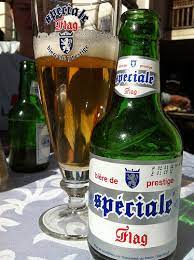In Morocco, alcohol is a prohibited commodity for Muslims. Political authorities and Moroccans in favor of alcohol prohibition rely on the Koran2 and hadiths to justify their opposition to the uses of alcohol, as well as on several laws that have been enacted since the French Protectorate that are not based on religious logic. As early as 1913, the legislative apparatus prohibited Muslims from buying, consuming and transporting alcohol, regulated the perimeter of bars around mosques and other public establishments, and regulated the presence of women. The implementation of this legislation was part of the “policy of respect” dear to H. Lyautey. According to the historian N. Znaien (2018, p. 87), the colonial authorities feared that North Africa would refuse to engage in the mobilization against Germany and sought to give pledges to Muslim public opinion: by legislating on alcohol, the aim was to show French goodwill in respecting Muslim customs. Other decrees concerning alcohol were then promulgated with the same objective: to regain political control in a period of social unrest. After independence, the kingdom’s regulation of alcohol was in line with that of the Protectorate. However, the condemnation of the uses of this product does not have only a legal dimension, it has indeed an essentially social dimension as we will see later.
Despite these prohibitions, the merchandise and its sales and consumption areas are present in the urban space, in a perfectly legal manner: there are about fifteen independent bars, a dozen hotel bars, and a dozen nightclubs (associated with a hotel or a bar). Alcohol is also sold in a dozen restaurants, four supermarkets and a dozen grocery stores. In the alcohol sections of the hypermarkets as well as in the specialized grocery stores, the public is diverse: all social classes are present but women and children are rare. In bars, the latter are absent, the only women present are generally prostitutes, but the social origin of the public present differs according to the establishment. Thus, the most disadvantaged people cannot afford to go to the most expensive bars and only drink in the cheaper, popular bars. The same situation can be observed in restaurants and nightclubs.
3 . Since 2012, I have been conducting observations in grocery stores, supermarkets, bars, restaurants (…)
Officially, drinking establishments are reserved for non-Muslim customers, but the reverse is true. In order to continue their activities in this context, alcohol traders and consumers must make sure that they are invisible. The marketing and consumption of these commodities thus takes place in ways that are specific to Moroccan society and that are internalized by socioeconomic actors. This article seeks to describe how the latter keep their use of alcohol quiet in order to be able to pursue it and what methods are used to circumvent the prohibitions. After having dealt with the question of the visibility of the spaces concerned by alcohol, it will raise the question of the visibility of the uses of this commodity. This fieldwork3 will thus allow us to question the limits between prohibitions, censorship and self-censorship and the nature of transgression in Morocco.
Hiding the spaces where alcohol is sold and consumed
In Meknes, alcoholic beverage outlets are always located in the new city and are forbidden outside this space. This situation is the result of laws that were enacted during the Protectorate. Indeed, by prohibiting the establishment of bars near mosques, the decree of January 27, 1913 excluded these establishments from Muslim neighborhoods that had many places of worship. It thus confined the drinking establishments only to the perimeter of the new, European cities and the mellâh, then deprived of mosques and populated respectively by Christians and Jews, who were thus entrusted with the activities and spaces related to alcohol, excluding de facto the Muslims.
Whether in a grocery store, a supermarket or a bar, the alcoholic nature of the goods sold influences the way the space is organized, which must guarantee the greatest possible invisibility for customers. The owners of these establishments conceal their presence, hide their interior spaces, the uses of alcohol and the social relations that are specific to them, by implementing adapted arrangements.
4 . Increasing the visibility of customers was perhaps the effect sought by the legislator for the (…)
In grocery stores selling alcohol, sidewalk storefronts are sometimes protected by railings. Until 2012, stickers for alcohol brands covered the window of some of these stores, or cartons of liquor packaging were stacked behind the windows. They obscured the customers inside but have now disappeared, as the government has banned alcohol advertisements.4
Supermarkets, on the other hand, have a separate area reserved for the sale of this merchandise. While other products are all in the same space, in different shelves, alcohol is always isolated. It is located in a room that can be closed by a metal curtain lowered during Ramadan and Muslim holidays, thus preventing any possibility of purchase. This space can benefit from an external exit door on the side of the store, away from the main entrance. This way, customers who come to shop have no contact with alcohol buyers, who can shop very discreetly.
5 . These curtains can be found on the windows of restaurants selling alcohol.
6 . Cafés do not sell alcoholic beverages.
The spatial organization of bars follows the same logic. Indeed, those have gable on street but their frontages are singular by their closed aspect. Their owners keep them out of sight with the help of different arrangements. Silver or smoked films glued on the windows make them opaque: the customer can see from the inside without being seen from the outside. Grilles are sometimes fixed on the fronts and, inside, thick curtains are drawn at night5. The entrance to the bars is also arranged. For example, it is a corridor closed at both ends by a door, one opening onto the street and the other onto the bar room. Sometimes a partition of about 1.80 meters high is placed at an angle inside, in front of the entrance door, preventing the tables behind and the customers from being seen from the street. A curtain is also used that is fixed in the doorway and that comes down to the middle of the door. This allows the front door to be left ajar to let air in because of the heat. Between the sidewalk and the interior of the bars, visibility is nil, but communication is possible while still remaining indirect. In the cafés6 , it is the opposite: no grids or curtains, the doors and windows remain open and when they are closed, they are closed only by a window.
It can also be observed that when a bar closes permanently and is converted into a café, the opaque films are removed or the windows are left open, allowing the customers inside to be seen from the street.
The space of nightclubs is not original, since, in all countries, it is characterized by the absence of windows and by the presence of an imposing entrance door that prevents the view inside while filtering the clientele.
The mechanisms of concealment do not only concern the organization of the distribution and consumption spaces but also the activities that animate them, whether it is the delivery, purchase and sale of alcohol.
Masking the circulation of alcohol
Indeed, the circulation of this merchandise also responds to the logic of Moroccan society. Drink distributors always deliver their goods to bars and restaurants by truck. When it comes to non-alcoholic beverages, the vehicles are always unhitched, so that the boxes stacked between the sides can be seen from the street. When they deliver alcoholic beverages, it’s the other way around: tarpaulins hide the goods being transported while leaving no one unaware of the truck’s contents. This method of delivery was, it seems, less concealed until a few years ago; the boxes could circulate without tarpaulin before the 1990s. Some legitimize this transformation by the need not to set a bad example to the youth and not to encourage them to consume alcohol by its free circulation in the public space. They add that if the deliveries were not masked, then this display could be interpreted as a sign of society’s agreement with the use of alcohol. However, it is also likely that the rise of the Justice and Development Party (PJD) has had an impact on alcohol-related practices: consumers and distributors have probably become more concealed after the arrival in power of this so-called “Islamist” party, which advocated the fight against alcohol and used the prohibition of alcohol as a political argument, in the manner of a “moral entrepreneur “
7. contributing to the labeling of this group constituted by alcohol users.
Not only is the delivery of this merchandise to the shopkeepers hidden, but also its circulation from the shop to the customer’s home. Carrying bottles risks making the purchase and its future consumption visible and introduces into the public space goods that should not be there. The grocer rolls up each bottle individually and the cans in twos or threes in a sheet of newspaper, then places them inside a plastic bag to be transported. The newspapers are used to make the contents of the bag more shapeless and to keep the bottles from making noise when they collide. These plastic bags are thicker and more opaque than the bags used to transport other goods. The customers are therefore walking down the street in full view of everyone, including the police, and everyone knows what is in the bags. Concealment is therefore relative: it is less a question of concealing a practice than of complying with the rules of this social game. Concealment here is an indication of respect for order. Nevertheless, the police sometimes stop these people in the street to ask them what they are carrying. They are then obliged to indicate the contents, and find themselves in violation. Some police officers let them go but keep the bottles, others ask for a bribe. As a result, alcohol consumers are constantly faced with the threat of being apprehended. In grocery stores that sell both liquor and general merchandise, or in those that do not sell alcoholic beverages, these bags are refused by some customers who do not buy or drink alcohol because “it will look like you bought alcohol. The use of these bags therefore has a double meaning depending on whether or not alcohol is consumed. For consumers, the use of these bags shows their respect for social norms that tolerate certain practices as long as they are hidden. For non-consumers, these bags are stigmatizing and refer to the consumption of a forbidden commodity. To use them is to expose practices that they otherwise reject.
8 . Fig brandy.
Alcohol is sold in this way by physically masking the merchandise, by removing its form. Consumers adhere to this way of doing things and reproduce it, as we shall see, when it comes to getting rid of their empty bottles. Some integrate it to such an extent that they themselves elaborate other strategies to show neither the alcohol they buy nor the blackout bags. For example, I have observed that some customers hide the bottles in a backpack or in the top of their pants, while others buy a bottle of mahia8 and pour the white alcohol into a half-full soda bottle or an empty water bottle before leaving the store. The alcohol is thus hidden, anonymized in its new container, “so that the police won’t see it, because it’s water…”.
9 . Like most grocery stores and bars.
The same purchasing practices can be observed in the supermarkets of Meknes. Once the bottles are in the cart, customers no longer go to the other part of the supermarket to do their regular shopping. To pay for their bottles, they have to go to a special cashier, specific to the alcohol section. The cashier also wraps the bottles in newspaper and puts them in the opaque plastic bags. Most supermarkets9 do not give receipts to customers who buy alcohol so that there is no material evidence that they have served alcohol to Muslims. Once out of the sales area, the customer seeks to conceal the bottles as they do when leaving the grocery stores.
Nevertheless, the circulation of alcohol can generate problems when the place of residence is inserted in a collective housing space, because it raises the question of the gaze of the neighbors and in particular that of the concierge, whom the inhabitants sometimes consider as an intelligence agent for the State. When you live in an apartment building, you have to be even more discreet, to be even more careful so that the merchandise is invisible in the common spaces and so that the neighbors do not see anything. However, as the following example shows, no one is safe from an accident, such as breaking a bottle in the elevator, which exposes the culprit to the eyes and criticism of his neighbors.
“Once, a gentleman who lives on the eighth floor brought a bottle of wine. When he tried to press the button on the elevator, it fell and broke. So his hands were wet with wine and he pressed the number eight. When I got off, I found a gentleman, a bearded man, who started to shout. I told him, “But it’s okay. I went upstairs and brushed it off. He said, “There it is, that’s the one, that’s the one on the eighth floor!” [laughs] he saw the fingerprint! He wanted to get a lot of people together to show them that, here’s someone who… But then, when I talked to him, he just gave in, and I swept it up, cleaned it up, and it went really well.
– And the gentleman on the eighth floor didn’t pick up the pieces of the bottle?
– No, no, no, he ran away [he says, clapping his hands] because for him, it’s shameful I think. So he ran away but he left the mark [laughs]. So I didn’t notice it because I’m not interested. I brushed it off and… he said “this is the eighth one that…”, I said “so what?”. He’s a shopkeeper with two kids, two daughters, someone who’s very good. Only, he was afraid of the constraint of… what will happen next.”
We can see here what consequences the visibility of alcohol in the collective space can have, both in terms of fear and escape for the person who thus makes his or her use of alcohol visible, and in terms of the reaction of people who do not consume it and the conflicts that can ensue. The incident is thus closed as soon as the object of the offence disappears, underlining the preponderance of visibility. The question of visibility arises not only through the transport of alcoholic beverages but also through the circulation of empty bottles.
When they want to get rid of their empty bottles, many people take care to isolate them from each other beforehand by rolling them up in newspaper before placing them in a plastic bag and throwing them in their garbage can, thus reproducing the commercial practices described above. Thus, when the person goes outside the dwelling to deposit the bag in the collective trash can at the bottom of the building, no one can identify the contents of their trash bag, nor the practices of the person carrying it.





